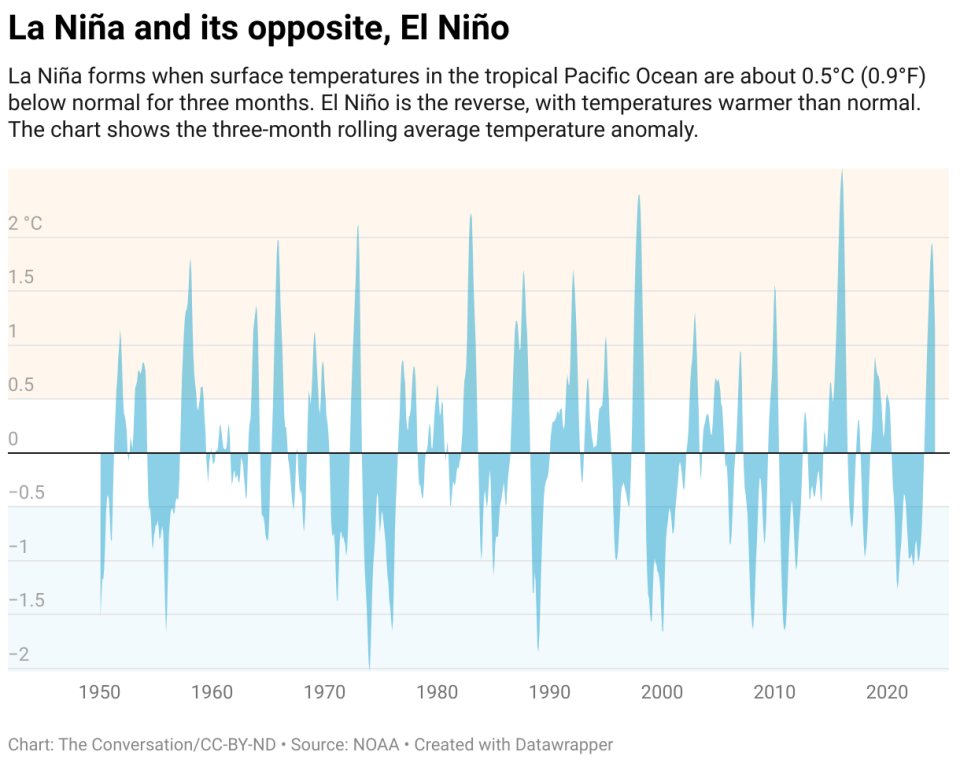One of the biggest drivers of last year’s record temperatures on Earth – El Niño – is almost gone, and its opposite, La Niña, is on its way.
Whether that’s a relief or not depends partly on where you live. Above-normal temperatures are still forecast in the US in the summer of 2024. And if you live along the U.S. Atlantic or Gulf Coasts, La Niña can contribute to the worst possible combination of climate conditions for fueling hurricanes.
Pedro DiNezio, an atmosphere and ocean scientist at the University of Colorado who studies El Niño and La Niña, explains why and what lies ahead.
What is La Niña?
La Niña and El Niño are the two extremes of a recurring climate pattern that can affect weather around the world.
Forecasters know La Niña has arrived when temperatures in the eastern Pacific Ocean along the equator west of South America cool at least half a degree Celsius below normal. During El Niño the same region warms up.
Those temperature changes may seem small, but they can affect the atmosphere in ways that ripple across the planet.
The tropics have an atmospheric circulation pattern called the Walker Circulation, named after Sir Gilbert Walker, an early 20th century English physicist. The Walker circulation is basically made up of giant air loops that rise and fall in different parts of the tropics.
Normally, air rises over the Amazon and Indonesia because moisture from tropical forests makes the air there more mobile, and it comes down over eastern Africa and the eastern Pacific. During La Niña, these loops intensify, creating stormier conditions where they rise and drier conditions where they fall. During El Niño, ocean heat in the eastern Pacific shifts these loops, making the eastern Pacific stormier.
EL Niño and La Niña also affect the jet stream, a strong current of air that blows from west to east across the US and other mid-latitude regions.
During El Niño, the jet stream tends to push storms toward the subtropics, making these typically dry areas wetter. Conversely, mid-latitude areas where storms normally occur become drier as storms dissipate.
This year, forecasters expect a rapid transition to La Niña – likely by the end of summer. After a strong El Niño, like the one the world saw in late 2023 and early 2024, conditions tend to turn to La Niña fairly quickly. How long it will stick around is an open question. This cycle tends to go from extreme to extreme every three to seven years on average, but while El Niños are usually short-lived, La Niñas can last two years or more.

How does La Niña affect hurricanes?
Tropical Pacific temperatures also control wind shear over large parts of the Atlantic Ocean.
Wind shear is a difference in wind speeds at different heights or directions. Hurricanes have a harder time holding their column structure during strong wind shear because stronger winds higher up push the column apart.
La Niña produces less wind shear, removing a brake on hurricanes. That’s not good news for people living in hurricane-prone areas like Florida. In 2020, during the last La Niña, the Atlantic Ocean experienced a record 30 tropical storms and 14 hurricanes, and in 2021 there were 21 tropical storms and seven hurricanes.
Forecasters are already warning that this year’s Atlantic storm season could rival 2021, largely due to La Niña. The tropical Atlantic Ocean has also been exceptionally warm, with sea surface temperatures breaking records for more than a year. That heat affects the atmosphere and causes more atmospheric movements over the Atlantic Ocean, fueling hurricanes.
Does La Niña mean drought is returning to the southwestern US?
The water supply in the southwestern US will likely be fine for the first year of La Niña because of all the rain this past winter. But the second year tends to be problematic. A third year, as the region saw in 2022, could lead to serious water shortages.
Drier conditions also mean more extreme fire seasons in the West, especially in the fall when winds increase.
What happens in the Southern Hemisphere during La Niña?
The effects of El Niño and La Niña are almost a mirror image in the Southern Hemisphere.
Chile and Argentina often suffer from drought during La Niña, while the same phase leads to more rain in the Amazon region. Australia suffered severe flooding during the last La Niña. La Niña also favors the Indian monsoon, which means above-average rainfall. However, the effects are not immediate. In South Asia, for example, the changes usually appear a few months after La Niña officially appears.
La Niña is pretty bad for East Africa, where vulnerable communities are already in prolonged drought.
Does climate change influence the impact of La Niña?
El Niño and La Niña are now happening on top of the effects of global warming. That could worsen temperatures, as the world saw in 2023, and precipitation could be off the charts.
Since the summer of 2023, the world has seen ten consecutive months of record-breaking global temperatures. Much of that heat comes from the oceans, which are still at record temperatures.
La Niña should cool things down a bit, but the greenhouse gas emissions that drive global warming are still increasing in the background. So while fluctuations between El Niño and La Niña can cause short-term temperature fluctuations, the overall trend is toward a warming world.
This article is republished from The Conversation, an independent nonprofit organization providing facts and analysis to help you understand our complex world.
It was written by: Pedro DiNezio, University of Colorado Boulder.
Read more:
Pedro DiNezio receives funding from NSF.